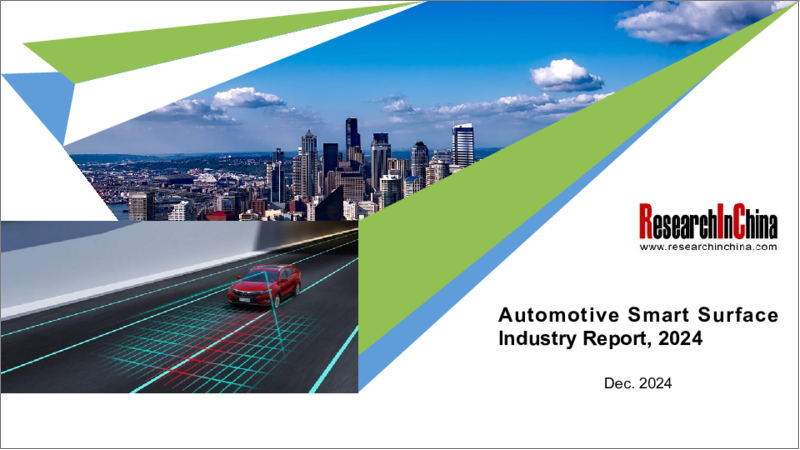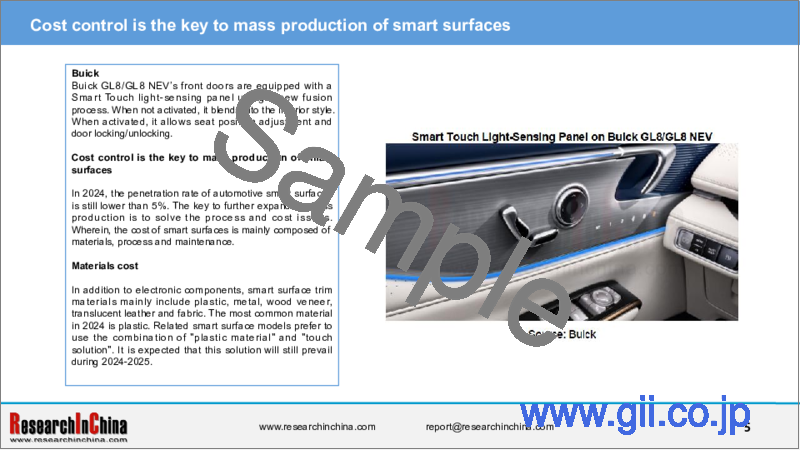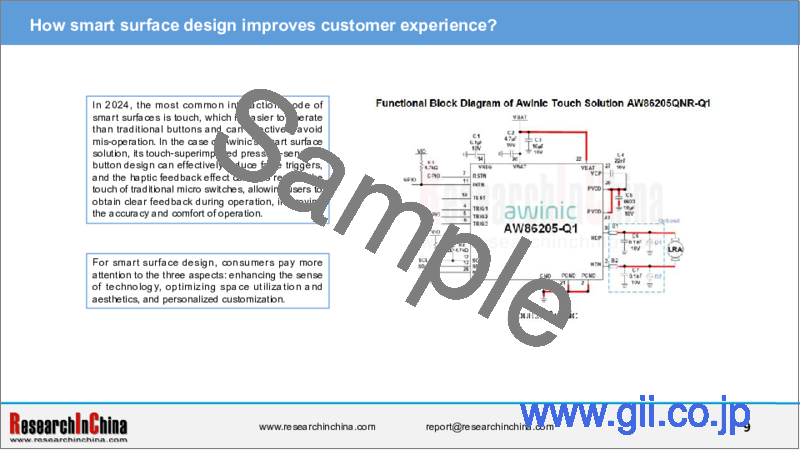|
|
市場調査レポート
商品コード
1613813
中国の自動車用スマートサーフェス産業(2024年)Automotive Smart Surface Industry Report, 2024 |
||||||
|
|||||||
| 中国の自動車用スマートサーフェス産業(2024年) |
|
出版日: 2024年12月08日
発行: ResearchInChina
ページ情報: 英文 260 Pages
納期: 即日から翌営業日
|
全表示
- 概要
- 目次
スマートサーフェスの売上は前年比105.1%と急増
2024年、自動車用スマートサーフェスは急速に普及し、普及率は上昇します。
2023年1月~9月のスマートサーフェス搭載モデルの売上は25万6,000台に達しました。
2024年1月~9月のスマートサーフェス搭載モデルの売上は52万5,000台、前年同期比105.1%、普及率は3.4%でした。
スマートサーフェスの搭載場所は主に、ステアリング、センターコンソール、ドア、ダッシュボード機能ゾーンなどに集中しており、センシング/温度調整/照明機能を提供しています。
2024年1月~9月のスマートサーフェス搭載モデルのうち、センターコンソールへの搭載がもっとも多く、売上は23万4,000台に達し、ドア、天井、ステアリングホイールへの搭載は前年同期比で急成長し、それぞれ11万1,000台、2万1,000台、7万5,000台に達しました。
内容
センターコンソールにスマートサーフェスインテリアトリムを採用し、インフォメーションディスプレイやエアコンなどの多機能を統合し、元々煩雑だったボタンをシンプルなタッチコントロールインターフェースに変えることで、センターコンソールの外観をよりシンプル、エレガント、モダンにしました。
ドアインテリアパネルには、スマートサーフェスデザインを採用し、タッチ操作でドアロックコントロール、ウィンドウコントロールなどの統合操作を可能にするとともに、休止中は関連機能を隠すことができ、ドアインテリアの装飾的価値を高めています。
ステアリングホイールのスマートサーフェスは、ボリューム調整やドライビングモードの切り替えなど、複数の機能をコントロールでき、ドライバーの操作性を向上させています。
Camry
2024 Camryは、センターコンソールに静電式タッチパネルとパターン化した透明パネルを採用し、エアコンの温度、風向、ガラスヒーターなどのタッチコントロールに対応しています。
Buick
Buick GL8/GL8 NEVのフロントドアに、新融合プロセスによるスマートタッチ光センサーパネルを採用。休止中はインテリアスタイルに溶け込みます。作動させると、シートポジション調整とドアのロック/アンロックが可能になります。
スマートサーフェス量産化の鍵はコストコントロール
2024年時点では、自動車用スマートサーフェスの普及率はまだ5%未満です。量産をさらに拡大する鍵は、プロセスとコストの問題を解決することです。ここで、スマートサーフェスのコストは主に材料、プロセス、メンテナンスで構成されます。
材料コスト
電子部品のほか、スマートサーフェストリム材料には主にプラスチック、金属、木製ベニヤ、半透明レザー、ファブリックが含まれます。2024年にもっとも一般的な材料はプラスチックです。関連するスマートサーフェスモデルは、「プラスチック材料」と「タッチソリューション」の組み合わせを好んで使用しています。2024年~2025年も、このソリューションが主流になると予測されます。
プロセスコスト
スマートサーフェスの生産プロセスには、IMD(IML/IMRを含む)、IME、OMDなど複数のルートがあります。実利用では、メーカーはコストと効果に応じてプロセスルートを選択します。2023年と比較すると、2024年のスマートサーフェスのサプライチェーンメーカー数はさらに増加し、IMEプロセスがより大規模に使用されます。IML/IMRのようなルートに比べて、IMEは高いコストにもかかわらず、より軽量で複雑なプロセスを実現できます。
サプライヤーにとって、構造設計方式を変更するよりも新しいスマートサーフェス材料を開発する方が難しいため、サプライヤーはスマートサーフェスアクセサリの構造を変更したり、設計方式を最適化したりする傾向にあります。
当レポートでは、中国の自動車用スマートサーフェス産業について調査分析し、開発史、技術、材料、搭載場所などの概要に加え、スマートサーフェス企業や自動車メーカーの情報を提供しています。
目次
第1章 自動車用スマートサーフェス産業の概要
- 自動車用スマートサーフェスの定義
- 自動車用スマートサーフェスの開発史
- 自動車用スマートサーフェス技術のイントロダクション
- 自動車用インテリジェントサーフェス材料
- 自動車用スマートサーフェスの搭載場所
- 動向の分析
第2章 自動車用スマートサーフェスのTier 1企業
- FORVIA
- Antolin
- Continental
- Marelli
- Yanfeng
- Minth Group
- Changshu Automotive Trim (CAIP)
- Joyson Electronics
第3章 自動車用スマートサーフェスサプライチェーンの企業
- Dupont
- Tactotek
- CondAlign
- Covestro
- Marquardt
- CGT
- UltraSense
- TouchNetix
- Sekisui
- e2ip
- Canatu
- Kurz
- MacDermid
- Nextinput
- Daming Electronics
- Ways Electron
- Ningbo Huaxiang Electronics
- Zhenghai Technology
- Tinychip
- Awinic Technology
- Sunlord Electronics
- CVA Chip
第4章 OEMの自動車用スマートサーフェス向けソリューション
- スマートサーフェスモデルのサマリー(1):1月~10月の新スマートサーフェスモデル(2024年)
- スマートサーフェスモデルのサマリー(2):7月~12月の新スマートサーフェスモデル(2023年)
- スマートサーフェスモデルのサマリー(3):代表的なスマートサーフェスモデル
- Mercedes-Benz
- BMW
- Ferrari
- Volkswagen
- SAIC-GM Buick
- FAW Hongqi
- Changan Avatr
- Geely
- Chery
- SAIC I Motors
- その他のスマートサーフェスモデル
Research on automotive smart surface: "Plastic material + touch solution" has become mainstream, and sales of smart surface models soared by 105.1% year on year
In this report, smart surface refers to an interior technology that is used outside the vehicle or inside the cabin and is integrated with various interior materials (including but not limited to leather, fabric, wood, glass, plastic, natural fiber, metal, etc.) through electronic sensors. It can be "functionalized" (for decoration or issuing commands) and can generate light and heat, or issue commands, sounds, etc. when activated.
Sales of smart surface models surged by 105.1% year on year
In 2024, automotive smart surfaces find very rapid adoption, with a rising penetration rate:
From January to September 2023, sales of models equipped with smart surfaces reached 256,000 units.
From January to September 2024, sales of models equipped with smart surfaces climbed to 525,000 units, soaring by 105.1% on a like-on-lie basis, with a penetration rate of 3.4%.
From the perspective of installation locations, smart surfaces are mainly concentrated in steering wheel, center console, doors, dashboard functional zone, etc., providing sensing/temperature control/lighting functions.
From January to September 2024, among the smart surface models, most applied smart surfaces to the center console, with sales up to 234,000 units; those that applied smart surfaces to doors, ceiling, and steering wheel grew rapidly year on year, with sales reaching 111,000 units, 21,000 units, and 75,000 units, respectively.
Wherein:
The center console adopts smart surface interior trims, integrating multiple functions such as information display and air conditioning, and transforming the originally cumbersome buttons into a simple touch control interface, thus making the center console look more simple, elegant and modern in appearance;
On the door interior panel, the smart surface design enables integrated operation of door lock control, window control and other functions through touch, and supports hiding related functions when not activated, enhancing the ornamental value of door interiors;
The smart surface on the steering wheel allows for control over multiple functions, for example, volume adjustment and driving mode switching, making it easier for the driver to operate.
Camry
The 2024 Camry uses electrostatic touch and patterned transparent panel at the center console, supporting touch control on air-conditioner temperature, wind direction, glass heating and other functions.
Buick
Buick GL8/GL8 NEV's front doors are equipped with a Smart Touch light-sensing panel using a new fusion process. When not activated, it blends into the interior style. When activated, it allows seat position adjustment and door locking/unlocking.
Cost control is the key to mass production of smart surfaces
In 2024, the penetration rate of automotive smart surfaces is still lower than 5%. The key to further expanding mass production is to solve the process and cost issues. Wherein, the cost of smart surfaces is mainly composed of materials, process and maintenance.
Materials cost
In addition to electronic components, smart surface trim materials mainly include plastic, metal, wood veneer, translucent leather and fabric. The most common material in 2024 is plastic. Related smart surface models prefer to use the combination of "plastic material" and "touch solution". It is expected that this solution will still prevail during 2024-2025.
Process cost
There are multiple smart surface production process routes, including IMD (including IML/IMR), IME and OMD. In actual applications, manufacturers will choose the process route according to cost and effect. Compared with 2023, the number of smart surface supply chain manufacturers in 2024 further increases, and the IME process is used on a larger scale. Compared with routes such as IML/IMR, IME can achieve lighter weight and more complex processes despite high cost.
For suppliers, it is more difficult to develop new smart surface materials than change the structural design scheme, so suppliers tend to change the structure of smart surface accessories and optimize the design scheme, for example:
Through modular design, smart surface components can be integrated into different interior modules within a limited space, reducing installation and maintenance costs;
In terms of the selection of touch chips, a more integrated chip design is adopted to reduce circuit volume and energy consumption;
In terms of latency, capacitive touch sensor with higher sensitivity is used to improve the response speed and accuracy of smart surfaces to user operation;
In terms of communication, to achieve seamless connection with the overall electronic system of vehicles, the faster and more stable CAN - FD protocol is adopted.
How smart surface design improves customer experience
In 2024, the most common interaction mode of smart surfaces is touch, which is easier to operate than traditional buttons and can effectively avoid mis-operation. In the case of Awinic's smart surface solution, its touch-superimposed pressure-sensitive button design can effectively reduce false triggers, and the haptic feedback effect can also restore the touch of traditional micro switches, allowing users to obtain clear feedback during operation, improving the accuracy and comfort of operation.
For smart surface design, consumers pay more attention to the three aspects: enhancing the sense of technology, optimizing space utilization and aesthetics, and personalized customization.
Enhance the sense of technology
Automotive smart surface fully meets customers' pursuit of a sense of technology, with the cool touch interaction mode and futuristic display effects:
In terms of touch sensing, capacitive touch technology is used to build a highly sensitive touch sensing matrix. Whether it is a light touch, a slide or a multi-touch gesture, it can achieve accurate and rapid response. The response time can be as low as a few milliseconds, effectively avoiding the adverse experience caused by operation delays.
In terms of touch feedback, the built-in precision haptic feedback device, such as linear resonant brake or eccentric rotating mass motor, can generate suitable vibration feedback according to touch operation. For example, when selecting a menu, a gentle and short vibration will be generated; when confirming an important operation, a slightly stronger and longer-lasting vibration prompt will be given, thus simulating the real touch of buttons and enhancing the intuitiveness and confirmability of the operation.
In terms of display, Micro LED or OLED technology is used to present functional logos in an intuitive graphical interface.
In March 2024, Antolin unveiled NEXUS, a door panel concept which is equipped with a touch smart surface. In addition to vision lighting, it also provides heating function using the interior adaptive thermal surface technology. Meanwhile, it supports electronic rearview mirror function for the 3D hologram driving assistance system, providing different information about the road outside the vehicle when needed.
Optimize space utilization and aesthetics
The complex layout of traditional buttons is easy to make the cockpit look cluttered, while smart surfaces can reduce the number of physical buttons through integrated design, for example, use electronic integration technologies such as system-in-package (SiP) and multi-chip module (MCM) to highly integrate such electronic components as originally scattered microcontroller unit (MCU), touch chip, display driver IC and various sensors into a compact module, effectively reducing the physical space occupied by electronic components and creating favorable conditions for optimizing the layout of other cockpit components.
The smart surfaces of relevant models in 2024 all support invisible touch function when not activated, making the overall cockpit more concise and elegant, creating a spacious, comfortable and beautiful visual experience in a limited space. For example, on the smart surface center console, multiple physical buttons originally used to control the air conditioning system, audio system, window lifting and driving mode switching are integrated into one or several simple touch zones. By presenting intuitive function icons and operation prompts on the display interface, it will make it easier for occupants to complete various complex operations.
In April 2024, Marelli launched a new invisible smart surface product, which adopts the design concept of "screen-free cockpit". The product is designed at the co-pilot seat, and installs a screen under the translucent surface trim with a thin film material covered with tiny holes on the surface. When activated, lights or LED/OLED in it will light up, and the light will pass through the tiny holes to display the control interface; when not wakened up, it will blend into the interior surface.
Personalization
Different consumers have different preferences for car interiors. Smart surfaces can be designed through process schemes to achieve different function layouts and display effects to meet personalized needs of consumers. For example, consumers can set theme color, display content, etc. of the center console smart surface as they like.
In April 2024, Changshu Automotive Trim launched a door ambient light, which is composed of wood grain LED, translucent PU leather and translucent fabric from top to bottom. All the three allows users to customize lighting later. Wherein, the wood grain LED enables occupants to customize the virtual touch function via the embedded inductive vibration mechanism.
Table of Contents
1 Overview of Automotive Smart Surface Industry
- 1.1 Definition of Automotive Smart Surface
- 1.2 Development History of Automotive Smart Surface
- 1.2.1 Development History of Automotive Smart Surface: Comparison of Technology Routes
- 1.2.2 Development History of Automotive Smart Surfaces: Phase 1
- 1.2.3 Development History of Automotive Smart Surfaces: Phase 2
- 1.2.4 Development History of Automotive Smart Surfaces: Phase 3
- 1.2.5 Application Scenarios of Smart Surface (Interior)
- 1.2.5 Application Scenarios of Smart Surface (Exterior)
- 1.3 Introduction to Automotive Smart Surface Technology
- 1.3.1 Automotive Intelligent Surface Technology - IMD (1)
- 1.3.1 Automotive Intelligent Surface Technology - IMD (2)
- 1.3.1 Automotive Intelligent Surface Technology - IMD (3)
- 1.3.1 Comparative Analysis of IMD Technologies
- 1.3.2 Automotive Intelligent Surface Technology - IME
- 1.3.2 Automotive Intelligent Surface Technology - IME Process
- 1.3.2 Automotive Intelligent Surface Technology - IME Advantages
- 1.3.2 Comparative Analysis of IME and IMD
- 1.3.2 Automotive Intelligent Surface - Market Size of IME 2020-2025
- 1.3.3 Automotive Intelligent Surface Technology - TOM
- 1.3.3 Comparative Analysis of TOM and IMD
- 1.4 Automotive Intelligent Surface Materials
- 1.4.1 Different Types of Smart Surface Decorative Films (1)
- 1.4.1 Different Types of Smart Surface Decorative Films (2)
- 1.4.1 Different Types of Smart Surface Decorative Films (3)
- 1.4.2 Automotive Smart Surface Materials: Translucent Skin
- 1.4.3 Automotive Smart Surface Materials: Smart Fabric
- 1.4.4 Automotive Smart Surface Materials: Transparent Conductive Electrodes (1)
- 1.4.4 Automotive Smart Surface Materials: Transparent Conductive Electrodes (2)
- 1.4.5 Performance Comparison between Transparent Conductive Electrode Materials
- 1.4.6 IME Applications for Touch Control
- 1.4.7 Integrated Materials
- 1.5 Installation Places of Automotive Smart Surface
- 1.5.1 Application of Automotive Smart Surface (1)
- 1.5.1 Application of Automotive Smart Surface (2)
- 1.5.2 Automotive Smart Surface Application - HMI Control Panel
- 1.5.3 Automotive Smart Surface Application - Overhead Console
- 1.5.4 Automotive Smart Surface Applications - Heater/Display
- 1.6 Trend Analysis
- 1.6.1 Development Trends of Automotive Smart Surface: Overview
- 1.6.2 Trend 1: Smart Surface Models Have a Growth Rate of 34.7%
- 1.6.3 Trend 2: The "Plastic Material + IML/IME" Solution is Expected to Become the Mainstream Solution
- 1.6.4 Trend 3: Distribution of Smart Surface Models by Vehicle Class/Price Range/OEM
- 1.6.5 Trend 4: Low-cost Materials and Technologies Are Becoming More Important
- 1.6.6 Trend 5: Multiple Technology Routes in Parallel
- 1.6.7 Trend 6: Combination of Smart Surface HMI Design and Multimodal Interaction
2 Automotive Smart Surface Tier1s
- 2.1 FORVIA
- 2.1.1 Profile
- 2.1.2 Five functions of Smart Surface
- 2.1.3 New Dynamics: Light and Shadow Seat
- 2.1.3 New Dynamics: Light Title
- 2.1.4 Smart Surface (1)-(9)
- 2.1.5 Intuition System
- 2.2 Antolin
- 2.2.1 Profile
- 2.2.2 Development History
- 2.2.3 Partners
- 2.2.4 Smart Surface Products
- 2.2.5 Dynamics: Cooperation with E INK
- 2.2.5 Dynamics: Recyclable Materials Used in Surface Products
- 2.2.6 NEXUS Smart Door Panel
- 2.3 Continental
- 2.3.1 Profile
- 2.3.2 Development History
- 2.3.3 Intelligent Cockpit Surface (Center Console)
- 2.3.4 Characteristics of Smart Surface
- 2.3.5 Structure of Smart Surface
- 2.4 Marelli
- 2.4.1 Profile
- 2.4.2 Smart Surface (Interactive Light Transmitting Decoration)
- 2.4.2 Smart Surface (Soft Touch Smart Surface)
- 2.4.2 Smart Surface (Center Console)
- 2.4.2 Smart Surface (Invisible Smart Surface)
- 2.5 Yanfeng
- 2.5.1 Profile
- 2.5.2 Business layout
- 2.5.3 Smart Surface (1)
- 2.5.3 Smart Surface (2)
- 2.5.3 Smart Surface (3)
- 2.5.4 Smart Surface Functions of XiM20-23 Series
- 2.5.5 XiM25
- 2.6 Minth Group
- 2.6.1 Profile
- 2.6.2 Development History
- 2.6.3 Product Application (1)
- 2.6.3 Product Application (2)
- 2.7 Changshu Automotive Trim (CAIP)
- 2.7.1 Profile
- 2.7.2 Intelligent Cockpit Interior
- 2.8 Joyson Electronics
- 2.8.1 Profile
- 2.8.2 Organizational Structure and Acquisition History
- 2.8.3 Smart Surface Business
- 2.8.4 3D Landscape Control
3 Automotive Smart Surface Supply Chain Companies
- 3.1 Dupont
- 3.1.1 Development History
- 3.1.2 Product Introduction
- 3.1.3 Smart Surface Business
- 3.1.4 Main Products of Smart Surface Business (1)-(4)
- 3.2 Tactotek
- 3.2.1 Profile
- 3.2.2 Main Products
- 3.2.3 IMSE Technology: Introduction
- 3.2.3 IMSE Technology: Process
- 3.2.3 IMSE Technology: Practical Cases
- 3.2.3 IMSE Technology: Features and Advantages
- 3.3 CondAlign
- 3.3.1 Main Business
- 3.3.2 Business Analysis
- 3.3.3 Conductive Film Products
- 3.4 Covestro
- 3.4.1 Makrolon Ai material
- 3.4.2 Makrofol Film
- 3.4.3 Bayfol Film
- 3.5 Marquardt
- 3.5.1 Mobile Living Room Combined with Smart Surface
- 3.6 CGT
- 3.6.1 Reveal Materials
- 3.7 UltraSense
- 3.7.1 Main Business
- 3.7.2 DynamicS
- 3.8 TouchNetix
- 3.8.1 Touch products
- 3.9 Sekisui
- 3.9.1 Main Business
- 3.9.2 Product Application (1)
- 3.9.2 Product Application (2)
- 3.9.2 Product Application (3)
- 3.9.2 Product Application (4)
- 3.10 e2ip
- 3.10.1 Profile
- 3.10.2 Product Application (1)
- 3.10.2 Product Application (2)
- 3.11 Canatu
- 3.11.1 Profile
- 3.11.2 Operation
- 3.11.3 Product Application (1)
- 3.11.3 Product Application (2)
- 3.12 Kurz
- 3.12.1 Profile
- 3.12.2 Operation
- 3.12.3 Product Application
- 3.13 MacDermid
- 3.13.1 Profile
- 3.13.2 Product Application (1)
- 3.13.2 Product Application (2)
- 3.13.2 Product Application (3)
- 3.13.2 Product Application (4)
- 3.13.2 Product Application (5)
- 3.13.2 Product Application (6)
- 3.13.2 Product Application (7)
- 3.13.2 Product Application (8)
- 3.14 Nextinput
- 3.14.1 Solid-state Entry-free solution
- 3.15 Daming Electronics
- 3.15.1 Business and Technology Introduction
- 3.16 Ways Electron
- 3.16.1 Profile
- 3.16.2 Business Introduction
- 3.16.3 Smart Surface Business Development
- 3.17 Ningbo Huaxiang Electronics
- 3.17.1 Profile
- 3.17.2 Main Business
- 3.17.3 Luminous interior
- 3.18 Zhenghai Technology
- 3.18.1 Profile
- 3.18.2 IML Business
- 3.19 Tinychip
- 3.19.1 Profile
- 3.19.2 TCAE10 Touch Solution
- 3.19.3 TCAE12/32 Touch Solution
- 3.19.3 TCAE32A Touch Solution
- 3.19.4 TCAE31A-QDA2 touch solution
- 3.20 Awinic Technology
- 3.20.1 Smart Surface Button Design Structure
- 3.20.2 Smart Surface Touch Feedback Technology
- 3.20.3 Smart Steering Wheel Solution: Design Solution
- 3.20.3 Smart Steering Wheel Solution: AW86205QNR-Q1 Case
- 3.20.3 Smart Steering Wheel Solution: AW86907QNR-Q1 Case
- 3.20.4 Chip Solution
- 3.21 Sunlord Electronics
- 3.21.1 Ambient Lighting Solution
- 3.22 CVA Chip
- 3.22.1 Touch Screen Products
4 OEM Solutions for Automotive Smart Surface
- Summary of Smart Surface Models (1): New Smart Surface Models, Jan-Oct 2024
- Summary of Smart Surface Models (2): New Smart Surface Models, Jul-Dec 2023
- Summary of Smart Surface Models (3): Typical Smart Surface Models
- 4.1 Mercedes-Benz
- 4.1.1 Concept Car
- 4.1.2 V-Class
- 4.1.3 GLE
- 4.2 BMW
- 4.2.1 7 Series
- 4.2.2 i5
- 4.2.3 iX
- 4.2.4 iX Flow Concept Car: Color Change Features
- 4.2.4 iX Flow Concept Car: Color Change Principle
- 4.3 Ferrari
- 4.3.1 Roma
- 4.3.2 Purosangue
- 4.4 Volkswagen
- 4.4.1 ID.7 VIZZION
- 4.4.2 Passat 2025
- 4.5 SAIC-GM Buick
- 4.5.1 GL8/GL8 New Energy
- 4.5.2 Verano
- 4.6 FAW Hongqi
- 4.6.1 EH7
- 4.6.2 HQ9
- 4.7 Changan Avatr
- 4.7.1 Avatr 07
- 4.7.2 Avatr 12
- 4.8 Geely
- 4.8.1 Geely Xingyuan
- 4.8.2 Volvo EX30
- 4.8.3 Volvo EM90
- 4.8.4 Zeekr 001
- 4.8.5 Geely Borui/Zeekr X
- 4.8.6 Seat Touch Panel
- 4.9 Chery
- 4.9.1 Tiggo 9 C-DM
- 4.9.2 Fengyun T10
- 4.10 SAIC IM Motors
- 4.10.1 IM L7
- 4.10.2 IM LS7
- 4.10.3 Principles of Smart Surface Control Technology
- 4.11 Other Smart Surface Models
- 4.11.1 Denza N7/8
- 4.11.2 ARCFOX Kaola
- 4.11.3 Camry
- 4.11.4 Xpeng X9
- 4.11.5 Luxeed R7
- 4.11.6 Cadillac






